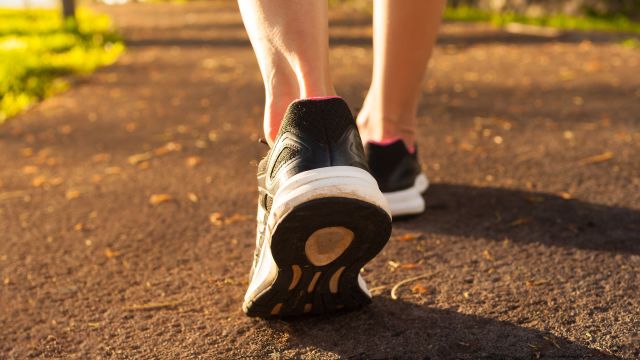When you’re recovering from heart disease, walking is a wonderful way to get back into shape. Many people are just learning that how fast you walk can be an important measure of your overall health.
In fact, after a heart attack, before you go home your doctors may ask you to walk for six minutes. How far you get is one way to judge your chances of survival over the next year. In a 2011 study published in JAMA, a team of experts evaluated data on more than 34,000 people age 65 and up living outside nursing homes. They concluded that seniors who can walk faster than 1.8 miles an hour are in the top half of the life expectancy chart, and that being able to walk 2.7 miles in an hour would give you “exceptional life expectancy.” On the other hand, if you become less mobile and slip into an inactive life your health could slip, too, or even spiral downwards.
Measure Your Progress
You don’t need to jog but you do need to push yourself a bit. Don’t just say—“I’ll go for walks.” Commit to a schedule and set goals. In many areas, you’ll find tracks at the local park. You’re also much more likely to improve if you wear a heart rate monitor or pedometer and track how long and quickly you walk. At first, plan on walking a minimum of 20 minutes a day. You might start with five minutes at a slower pace and then bring your heart rate up to at least 20-30 beats per minute above your resting rate.
Raise the bar as you improve. Over time, your routine will make you feel great—you’ll be breathing and pumping blood more efficiently and your legs will grow stronger and steadier.
Find a Fast Partner
Your ideal walking companion will challenge you. You’re in luck if she’s patient enough to stick with you at your pace for a while—perhaps one lap on a track. Then walk at her pace for the next lap. Let her know what your goals are and chances are she’ll help and encourage you.
Take the Stairs
I always laugh when I see people at gyms standing around waiting for the elevator, complaining that it’s slow. You can be the admirable person who always heads for stairs—and not just on the way down. Use stairs in your daily life and also in your walking routine. The climb will strengthen your legs and help boost your walking pace.
Build Your Muscles
Invest in at least one session with a trainer to learn how to build up your calves, hips and buttocks. You’ll need all those muscles to help improve your walking speed. But walking isn’t just about your legs. As professional sprinters know, you’ll be relying on other parts of your body as well. Strong arms–and a firm core–support you as you move. Pump your arms as you walk. Don’t forget to do exercises to strengthen your abdominal muscles, especially the plank position. A strong core will improve your control and balance.
Try the Beach, Grass, or Hiking Trails
A flat cement or blacktop surface isn’t as challenging as sand, grass, or any uneven surface. In fact, many athletes train on the sand, to get the most from their time. When you need to adjust to a changing surface, you build your balance, awareness and muscles. Exercising in nature is also especially good for your mental state.
Wear Walking Shoes
Invest in a shoe that cushions your foot and keeps it stable. Stay away from basketball or tennis sneakers or flimsy sandals. While good exercise shoes aren’t cheap, it will be money well spent to protect your feet and make your walks more effective and enjoyable.
Mix it Up
Walking exercises your whole body, but not every muscle. To improve your balance and overall fitness make a point of adopting activities other than walking—classes in a ballroom dance, yoga, tai-chi, or Zumba should strengthen other muscles and give you a workout. Take the time to master an activity you love, and your class will be a spot of pure joy in your week—week after week, year after year.
Walk to Explore
Once you build up your pace and strength, you’re likely to find that you feel freer and become more adventurous. On an island vacation with the kids, you can stroll well past the hotel’s square of beach. When you arrive in a new city, you might spend an hour exploring the downtown on foot rather than head for a tour bus. Many of us work hard for years dreaming of a retirement full of travel—make sure you’re fit enough to get a look around!
Exercise isn’t just about the benefits to your body, it also helps ward off mental decline as you age. Read about the brain-boosting benefits of exercise in Exercise to Help You Stay Sharp, Calm and Disciplined.
This content was originally published on Ornish Living.






